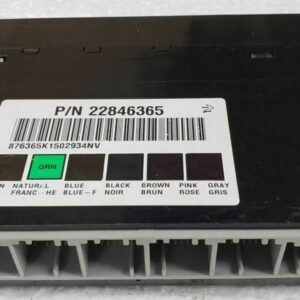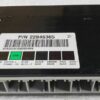Tired of Your Truck’s Mysterious Electrical Problems?
Is your Silverado or Sierra acting like it’s haunted? One minute the power locks don’t work, the next the radio is acting up, and the dash lights flicker for no reason. These frustrating and unpredictable electrical gremlins are often symptoms of a failing Body Control Module (BCM). As the central hub for your truck’s body electronics, a faulty BCM can cause chaos. This isn’t just an annoyance; it can affect critical systems. I’ve spent two decades diagnosing these issues, and I can tell you that replacing a failing BCM is the definitive solution to restore order and reliability to your vehicle.
This isn’t just any replacement part. This is your direct-fit, hassle-free solution. We take your vehicle’s VIN and program this module with the latest GM software specifically for your truck. It arrives at your door ready to install, saving you a costly trip to the dealership for programming. Get your truck’s features working correctly again with a reliable, pre-programmed 2012-2014 Sierra 2500 BCM.
A Technician’s Notebook: The Intermittent Gremlin
I remember a 2013 Silverado 2500 that came into the shop with a list of complaints that made no sense together. The owner said the dome light would stay on, the driver’s side window would work only half the time, and occasionally the ‘Service 4WD’ message would appear, even though the 4×4 system checked out fine. He’d been to two other shops that couldn’t find the problem because it was so intermittent. After checking the main networks and finding no communication loss, we focused on the BCM. By monitoring its data stream, we saw erratic outputs that didn’t match driver commands. A replacement BCM, programmed to the VIN, solved every single issue. It’s a classic case of how a single failing module can create a dozen confusing symptoms.
Is Your Truck Showing These Symptoms?
- ✔ Power windows, door locks, or mirrors operating erratically or not at all.
- ✔ Interior or exterior lights flickering, staying on, or not turning on.
- ✔ The security system or keyless entry failing to work correctly.
- ✔ Unexplained warning lights on the instrument cluster, such as for the airbag or traction control system.
- ✔ Communication error codes (U-codes) when scanned with a diagnostic tool.
- ✔ Wipers or radio malfunctioning without reason.
Your Straightforward BCM Installation Guide
Installing your new BCM is a manageable job for a confident DIYer. The module is typically located under the driver’s side of the dashboard, near the steering column.
- Safety First: Always disconnect the negative terminal from your vehicle’s battery and wait a few minutes before starting work.
- Locate the BCM: On most GM trucks from this era, you’ll find the BCM mounted to a bracket under the steering column. You may need to remove a lower dash panel for access.
- Disconnect and Remove: Carefully unplug the electrical connectors from the old BCM. They have locking tabs that need to be depressed. Once disconnected, unbolt or unclip the module from its mounting bracket.
- Install the New Module: Mount your new, pre-programmed BCM in the same location and securely plug in all the electrical connectors. You’ll hear a click as they lock into place.
- Reconnect and Test: Reconnect the negative battery terminal. Turn the key to the ‘On’ position (without starting the engine) and test all body functions: lights, locks, windows, wipers, etc.
Important Post-Installation Information
Because this BCM is pre-programmed, most vehicles will not require any further steps. However, depending on your truck’s specific configuration, a couple of simple relearn procedures may be necessary if you notice a warning light.
- Airbag System Sync: If the airbag warning light is on after installation, a professional scan tool is needed to perform the ‘Setup SDM Primary Key in BCM’ procedure. This syncs the new BCM with the airbag system. This is only required if the light appears.
- Brake Pedal Position Relearn: On some models, a brake pedal position sensor recalibration might be needed to ensure proper brake light and traction control operation. This is also done with a compatible scan tool.
Disclaimer: Specific procedures can vary by vehicle. Always consult a factory service manual or a qualified technician for guidance.
Will This Fit My Truck or SUV?
This Body Control Module is a direct replacement for part numbers 22737275, 22846365, and 22846364 and is guaranteed to fit the following GM vehicles:
- 2012-2013 Chevrolet Avalanche 1500
- 2012-2014 Cadillac Escalade, Escalade ESV, Escalade EXT
- 2012-2013 Chevrolet Silverado 1500 Pickup
- 2012-2014 Chevrolet Silverado 2500 & 3500 Pickup
- 2012-2013 GMC Sierra 1500 Pickup
- 2012-2014 GMC Sierra 2500 & 3500 Pickup (including Denali)
- 2012-2014 Chevrolet Suburban 1500
- 2012-2013 Chevrolet Suburban 2500
- 2012-2014 Chevrolet Tahoe
- 2012-2014 GMC Yukon & Yukon XL 1500
- 2012-2013 GMC Yukon XL 2500
Frequently Asked Questions
Why do you need my VIN?
Your VIN is essential because it allows us to load the exact software and vehicle-specific options (like keyless entry, power seat type, etc.) into the BCM. This ensures it works correctly right out of the box, just like an original part from the dealer.
Is this a job I can do myself?
Yes, for many people with basic mechanical skills, this is a straightforward DIY replacement. The module is accessible under the dash, and since we pre-program it, you avoid the most complex part of the job.
What if the airbag light comes on after I install it?
This can happen occasionally. It simply means the new BCM needs to be electronically ‘introduced’ to the airbag module. A repair shop with a professional-grade scan tool can perform the ‘Setup SDM Primary Key’ procedure in a few minutes to resolve this.
Do I need to return my old BCM?
No, there is absolutely no core charge for this part. You can keep your original module.
Will this fix my specific electrical problem?
This BCM will fix problems directly caused by a failing Body Control Module, such as issues with power accessories, lighting, and security systems. If you’re unsure, it’s always best to have a qualified mechanic diagnose the issue first.



